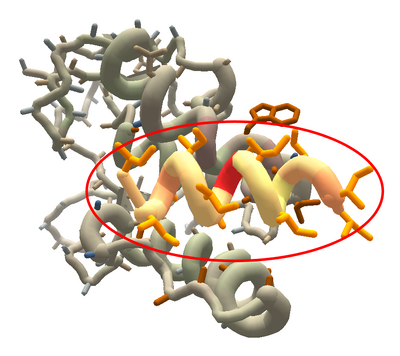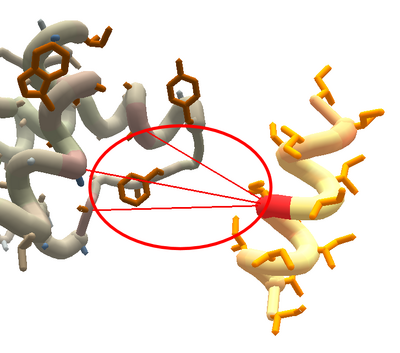
Docking Design. The circled yellow section can be designed. The rest of the protein is locked, although many sidechains can move.
Docking Design is a beginner puzzle. It's an example of one type of design puzzle found in Foldit.
This puzzle has two pieces. There's a small section of protein that can be designed. The much larger section of protein is locked, preventing you from mutating any segments. The backbone shape of the locked section also can't be changed, but many of the sidechains in the locked section can move to new positions.
The goal of this puzzle is to design the small section to bond to a specific spot on the larger protein target. A successful design could be used to develop new drugs or biological therapies for conditions related to the large protein.

Red constraints appear when the design section is moved too far from the target protein.
If you move the design section too far from the main protein, red constraints appear. The constraints act like bands, pulling the design section toward the target when you wiggle the protein. You can also use the move tool to adjust the position of the design section.
The puzzle also has a condition, the "Residue IE" condition, which checks to see that any phenylalanine, tyrosine, or tryptophan segments that you add are scoring well.
Tools and strategies[]
The design section is all isoleucine at the start of the puzzle.
To get started, you can try to mutate all segments. In the original interface, use the keyboard shortcut M (lowercase "m") or select "Mutate" from the Actions menu. In the selection interface, use the mutate icon or the Y (lowercase "y") keyboard shortcut. After mutating, shake and wiggle. You can repeat mutate, shake, and wiggle several times. Each time, the protein ends up a slightly different position, but you'll find that progress slows as you repeat the process.
You can also use the move tool to adjust the position of the design section. After moving the design section, you can again try mutating, shaking, and wiggling.
You're also free to change the secondary structure of the design section. The design section starts as a helix, which tends to score well in Foldit, but other shapes are possible.
You can also try to rebuild the design section, using a recipe like Tvdl enhanced DRW 3.0.1 (known as "EDRW").
At the start, you may want to adjust the wiggle power. Starting with low wiggle power speeds up recipes like EDRW. Switching to medium wiggle power can help to refine the protein towards the end of the puzzle.
Technical stuff[]
The large protein in this puzzle can be found the Protein Data Bank, as entry 1IJY. It's a mouse protein that's involved in how the animal develops. This protein also gets activated in many types of cancer. Binding to the protein might help fight these types of cancer.